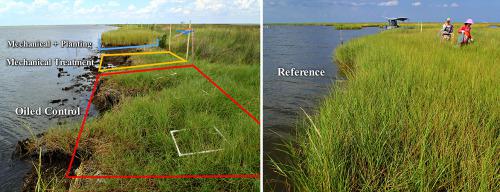Ecological Engineering ( IF 3.9 ) Pub Date : 2021-06-02 , DOI: 10.1016/j.ecoleng.2021.106288 Scott Zengel , Nicolle Rutherford , Brittany M. Bernik , Jennifer Weaver , Mengni Zhang , Zachary Nixon , Jacqueline Michel

|
The Deepwater Horizon oil spill (2010) resulted in ~100 km of heavily oiled salt marsh shorelines with severe marsh vegetation impacts. Approximately 27 km of these shorelines had marsh cleanup treatments aimed at limiting oil spread and facilitating ecological recovery. Heavy oiling impacts and disturbance from intensive cleanup treatments left marsh shorelines largely bare of live vegetation. Following operational-scale shoreline cleanup and experimental planting of Spartina alterniflora, we compared oiling degree and vegetation recovery among three types of heavily oiled salt marsh plots over three years: oiled control (no cleanup treatment, no planting); mechanical cleanup treatment (unplanted); and mechanical treatment coupled with planting. Nearby reference plots were used to define recovery targets and determine recovery progress. Mechanical treatment with planting showed the most improvement in oiling conditions and was most effective in re-establishing vegetation cover and dominant plant species composition approaching reference conditions. In contrast, the oiled controls and mechanical treatment plots without planting were similar and showed much slower recovery trends. Vegetation planting should be considered as a shoreline treatment or restoration approach for heavily oiled salt marshes, especially where oil impacted areas are left largely unvegetated, natural recovery is delayed, marsh shorelines are at risk of erosion, and as a possible condition for the use of intensive cleanup treatments. Vegetation planting following oil spills could be incorporated into shoreline treatment operations during emergency response as shoreline stabilization and for oil removal via phytoremediation, or as emergency restoration under the Natural Resources Damage Assessment (NRDA) process, to limit the degree and duration of natural resource impacts.
中文翻译:

在深水地平线漏油事件发生后,海岸线清理处理后的种植改善了盐沼植被的恢复
在深水地平线漏油事件(2010年)导致严重油污盐沼海岸线严重沼泽植被影响的约100公里。这些海岸线中约有 27 公里进行了沼泽清理处理,旨在限制石油扩散和促进生态恢复。密集的清理处理造成的严重油污影响和干扰使沼泽海岸线基本上没有活植被。在对互花米草进行规模化的海岸线清理和试验种植之后,我们比较了三年来三种重油盐沼地块的油污程度和植被恢复情况:油污控制(不清理处理,不种植);机械清理处理(未种植);和机械处理结合种植。附近的参考地块用于定义恢复目标并确定恢复进度。种植机械处理显示出油条件的最大改善,并且在重建接近参考条件的植被覆盖和优势植物物种组成方面最有效。相比之下,没有种植的涂油对照和机械处理地块相似,显示出更慢的恢复趋势。植被种植应被视为重油盐沼的海岸线处理或恢复方法,尤其是在受石油影响的地区大部分没有植被、自然恢复被延迟、沼泽海岸线面临侵蚀风险的情况下,以及作为使用密集清理处理的可能条件。溢油后的植被种植可以在应急响应期间作为海岸线稳定和通过植物修复去除油污或作为自然资源损害评估 (NRDA) 过程中的紧急恢复纳入海岸线处理操作,以限制自然资源影响的程度和持续时间.











































 京公网安备 11010802027423号
京公网安备 11010802027423号